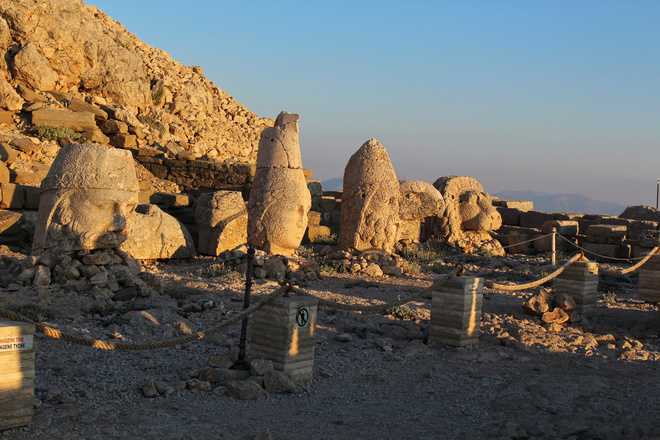Abode of the Gods
Tania Banerjee
In an obscure corner of Turkey, the rare few tourists hike up a hill in the wee hours of dawn and dusk from April to November. Braving the wind and chill, they climb up cement sealed stairs followed by a strenuous uphill ascent on loose gravel. They strain their muscles to finally reach the summit — all this effort to witness everyday celestial events — sunrise and sunset. Except on this peak, 2,134 m above the sea level, there are ancient onlookers accompanying them — a series of ancient statues of Gods and Goddesses from a syncretic religion, which had evolved from the influence of Persian, Armenian and Greek civilisations.
Situated in the Nemrut National Park, 86 km from the town of Adiyaman in eastern Turkey, far away from the tourist hotspot of Istanbul, the Nemrut Tumulus is a mausoleum erected on the peak of the highest mountain of the Commagene Empire by the Commagene king Antiochus I Theos in 62 BC for himself. The tumulus splits the crest into two — the east and the west terrace. The colossal statues, which flank the terraces, imprinted the name of the otherwise insignificant kingdom of Commagene in the pages of history forever. The existence of the monument was common knowledge to the locals but, in 1881, Karl Sester, a German engineer, brought the western world’s attention to Nemrut. The site secured a Unesco World Heritage tag in 1987 by virtue of the complex religious features represented by the monumental statues.
From the east terrace of the summit on a sunrise tour, one sees the silhouette of the Anti-Taurus Mountain Range gradually becoming sharper. Suddenly from a trough in the eastern mountain range, like a just-ignited wick of a candle, a fleck of fire burns. The rays of the sun light up the torsos of the statues resting on a podium. The heads, removed from the torsos, lie at the foot of the dais.
Durable yellow and white limestone blocks were set on top of each other in eight layers without any interlocking mechanism to form the statues. The bottom five layers are intact but the layers forming the arms and neck, heads and headgear are separated. Historians attribute the beheaded state of the originally 8 m high statues to natural disasters and deliberate human actions to mutilate them.
While Mithradates I, Antiochus’ father, was satisfied with relief carvings, which depicted him shaking hands with the gods, Antiochus took it one step further. He placed an effigy of himself sitting alongside the gods on Nemrut, signifying that he is one of them. On the eastern terrace, Antiochus is the rightmost statue, to his left is Goddess Commagene-Tyche dressed in Greek style wearing a wreath of plaited fruits on her head. A wise bearded Zeus-Orosmasdes captures the central position. Beside Zeus sits a clean shaven Apollo-Mithras and Heracles-Artagnes is the last God in the row, with a wrinkled forehead imparting a noble look. Massive statues of eagles and lions guard the thrones. The sculptures in the west terrace are a mirror image of the eastern ones, but they are poorly preserved compared to their eastern counterparts.
These divine entities introduced by Antiochus personify a combination of pagan Gods of both Hellenist and Zoroastrian pantheons — deities of a new cult developed at the intersection of the two. Straddling between Rome and Parthia, by the bank of river Euphrates, Commagene was an important buffer state, which served as the gateway in the business corridor between the east and the west. Antiochus, with his Greek, Persian and Armenian roots, was striving to define an indigenous cultural identity of Commagene, which would reflect his own origins.
On the Nemrut mountain crest, an artificial mound of crushed rock, 50 m high and 150 m in diameter — the tumulus of the controversial grave of Antiochus — is an unsolved mystery. Inscriptions deciphered by experts point to the existence of Antiochus’ grave here but several historians and archaeologists have spent a lifetime at the site failing to unearth the elusive grave of Antiochus. The explanations of experts vary widely — some say the tomb is underneath or even in another location and Nemrut tumulus was just a facade to mislead grave robbers and evil demons.









